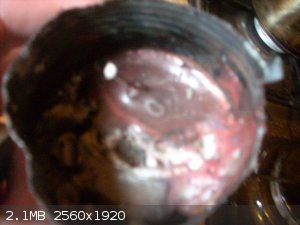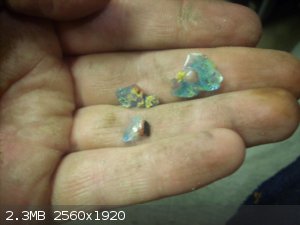tsathoggua1
Hazard to Others
  
Posts: 335
Registered: 8-1-2017
Location: Beyond the pale
Member Is Offline
Mood: Phosphorescent
|
|
Boron (amorphous)
Just been doing a bit of tinkering, and decided to see if I could reduce borax by means of electrolysis. Wikipedia states that a brown powder
precipitates from aqueous solutions of borate salts, although before reading this, I'd decided to try it on fused borax.
I think the result is probably a solid solution of amorphous boron (the brown amorphous, non-crystalline allotrope) in borax. Now going to try
dissolving away any borax after first powdering the result.
It started out as pure white BP-grade borax, container used was a bog standard steel tin formerly used to hold nosh of some kind, and one electrode of
a 12v car battery charger (although thats now buggered, transformer blew, but, my old man h as given me a variable output power supply, that afaik is
protected from damage due to short circuiting as it essentially is when being used for electrolysis. capable of 15V@14amps or 5v@35A.
So, going to give a saturated borax solution some juice, using a couple of pieces of copper wire as electrodes, or carbon rods if I can find any in
some of the big jar of dead batteries kept around.
What do the rest of you make of this (the attempt at electrolysis of fused borax) gone from white to brown, I think there may possibly have been some
discoloration from the blackish oxidation of the tin can itself, but the brown coloration extends right through to the center and is very different
from the black oxidation on the can edges. The color of the product is a kind of ruddy-brownish-reddish-orange color and the electrode itself (not
sure whether it was the anode or cathode because being intended for charging car batteries, they are lead-acid accumululators and are apolar, so there
were no polarity indicators on the leads.)

|
|
|
tsathoggua1
Hazard to Others
  
Posts: 335
Registered: 8-1-2017
Location: Beyond the pale
Member Is Offline
Mood: Phosphorescent
|
|
Using the new power supply, at 5V35A and copper/brass electrodes something interesting happened. Initially the borax looked like a sort of dirty melt,
I'd used the container that held what I believed might be a solid solution of boron in borax, to form a second melt using the new power supply and
this time used copper wire connected to a brass electrode and an electrode taken out of an alkaline battery since I couldn't find any Zn/C batteries.
The result was interesting, some brown deposited on the brass electrode, which I think could possibly be amorphous boron. But surrounding this, the
melt that was situated between the two electrodes formed a glass, with yellow, to brown crusts on the bottom of the pieces, which could be, and were,
dug out of the borax melt. The interesting part, is that they are of a very attractive pale blue color. Anbody care to speculate on the chemistry
going on here?
This vitreous material is very slippery when dry, and a steel screwdriver tip cannot scratch it

|
|
|
m1tanker78
National Hazard
   
Posts: 685
Registered: 5-1-2011
Member Is Offline
Mood: No Mood
|
|
Borax is sometimes used to flux copper/bronze for brazing. The 'glass' beads you gathered are most likely bits of solidified anhydrous borax with
copper salt contamination. Anhydrous borax is unstable in moist air and eventually reverts to its hydrated form(s).
Chemical CURIOSITY KILLED THE CATalyst.
|
|
|
tsathoggua1
Hazard to Others
  
Posts: 335
Registered: 8-1-2017
Location: Beyond the pale
Member Is Offline
Mood: Phosphorescent
|
|
Yes I knew that.
I will immerse a sample in H2O to ascertain stability and leave it overnight.
There is also an amorphous vitreous form, although this is stated to be black glass, and very hard. Presumably similar to glassy carbon in nature.
This material formed only in the zone between the electrodes, which is what makes me curious about its nature, it could be easily dug out of the
remaining melt, just borax, which could be chipped and broken away with ease (conditions of melting-maximum heat on a hotplate and liquefaction with a
brazing torch.
I assumed the blue color to be incorporation of copper, but this is very different to the remainder of the borax melt which was away from the
electrodes. And it is very hard. Thin pieces unsurprisingly can be broken with tools but chunks of it won't take a scratch from sharp steel points.
|
|
|
tsathoggua1
Hazard to Others
  
Posts: 335
Registered: 8-1-2017
Location: Beyond the pale
Member Is Offline
Mood: Phosphorescent
|
|
A sample of this blue, hard, vitreous compound was placed in sufficient water to cover it and left in a cup overnight. No change observed on checking
it at around 8am.
Will try steel nails as electrodes next, as well as electrolysis of aqueous borax and boric acid (to be prepared via treatment of borax with excess
HCl and subsequntly fractionally precipitating off as much boric acid as possible. Perhaps purification as an alkyl borate ester, following
distillation of same.
The samples believed perhaps to be amorphous boron are coated with a little fused borax from where they were chipped out from the melt of the first
experiment. These are of a roughly chocolate brown colour with a ruddy tint, hard, and break with a conchoidal fracture. As do the clear, blue
apparently insoluble pieces. These if broken give a razor-sharp edge after fracturing in a chonchoidal manner.
|
|
|
tsathoggua1
Hazard to Others
  
Posts: 335
Registered: 8-1-2017
Location: Beyond the pale
Member Is Offline
Mood: Phosphorescent
|
|
Meant to add, these brown pieces, I do not believe to be caused by iron contamination, since there was a white layer of anhydrous borax coating them,
and if Fe were contaminating it donating a reddish-ruddy color then it would have had to pass through the layer of borax which had to be cleaned off,
and which interposed between the can used as a container and the possible amorphous boron.
Could a sintering process perhaps have occured to produce it in a vitrified state? IIRC the aztec, or inca, forget which, used to produce elemental
platinum jewellery, and a charcoal fire cannot melt Pt, by alloying native alluvial Pt with gold/silver dust and melting it out, sintering the result
in the process.
How 'not stable towards' is fused anhydrous borax? because I've been keeping the shard of blue 'crystal' (I'll call it that to save having to type the
likes of 'piece of potential copper-doped and/or boron doped amorphous vitrified fused borax/boron'
|
|
|
tsathoggua1
Hazard to Others
  
Posts: 335
Registered: 8-1-2017
Location: Beyond the pale
Member Is Offline
Mood: Phosphorescent
|
|
After some more experimentation with the product from fusion of borax with a blowtorch, then application of current to the melt, this mostly ruddy
brown material precipitates out.
I really don't think its fused borax, since its taken a tungsten carbide cutting tool to put a scratch on the surface (of the reddish stuff)
|
|
|